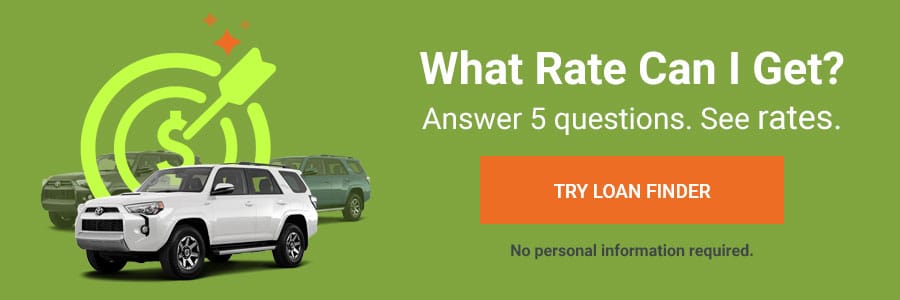You might be able to pay your car payment with a credit card. But you probably shouldn’t.
People use credit cards for a variety of reasons. For some, a credit card can be an effective way to exploit reward program perks and rack up incentives. For others, a credit card can be a lifeline and way to make ends meet. It all just depends on your particular financial situation and needs.
If one of your current needs includes purchasing a brand new car (or a used car that’s new to you) you may be asking yourself, “Can I pay my car payment with a credit card?”
Although most lenders don’t allow borrowers to use credit cards for car payments, it is possible to use plastic to pay for your steel, rubber, and aluminum (read: your car). It just might take some extra financial maneuvering.
But is making a car payment with a credit card a wise move? That depends. There are definitely some downsides. So before you get out your American Express, let’s explore some payment options.
How to Make a Car Payment With a Credit Card
Your ability to make a car payment with a credit card depends on whether your lender allows it. If it does, then you’ll likely have to add your card information on the lender’s web portal or mobile app. Or, if they don’t have an online platform, you might have to make payments in person or over the phone.
Generally speaking though, financial institutions aren’t a big fan of borrowers using debt to make a car purchase, down payment, or even just pay off auto loans in installments. And that’s exactly what you’re doing in this case.
However, there are ways around this — but they will likely cost you more in the long run.
Cash advance
Functionally speaking, a credit card cash advance works like a debit card. You’d go to your bank or an eligible ATM and use your credit card to withdraw cash. Then you could deposit these funds into your bank account and apply them to your car payment.
However, unlike a debit card, you’re borrowing money against your credit limit — so you have to pay this money back.
A cash advance is akin to a short-term cash loan. In most cases, these loans are extremely expensive and start accruing interest immediately at exorbitant rates. Don’t be surprised by rates of 18% to 30%.
And that might not even include the transaction fee, which varies based on the amount of the advance.
Additionally, your credit limit is not the same as your cash advance limit. Credit card issuers normally set cash advance limits much lower than total credit limits. So, depending on your card agreement, you might not be able to cover your entire car payment with a cash advance. Even if you can, you might have to pay back the cash advance before you can draw against this limit again.
Balance transfer
The most common use of a balance transfer is to move high-interest credit card debt to a cheaper card, particularly one with a temporary 0% introductory APR. In turn, you can minimize your total interest charges while you pay off the balance of your new card.
If your lender allows it, you might be able to transfer your auto loan balance to a 0% APR credit card. Your balance transfer credit card provider might give you a paper check to pay off your auto loan. The debt would then transfer to your credit card balance.
A balance transfer could help you limit your interest expense, in theory. But fees can quickly eat into savings. In some cases, balance transfer fees are 3% — which can amount to a significant cost depending on your loan balance (e.g., 3% of $20,000 is $600). And all this assumes (a) your loan can fit within your credit card limit and (b) you pay off the balance before your promotion ends.
Also, don’t be surprised if your credit score takes a significant hit. Credit utilization measures your outstanding credit balances against your total credit limit. It’s a major component of your credit scores. Installment loans,
such as mortgages and auto loans, don’t factor into this metric — only revolving debt does.
Even just by loading your minimum payment for an auto loan onto a credit card, you could significantly reduce your available credit and hurt your scores.
Money order
A money order is essentially a prepaid check. It’s addressed to a specific party and paid ahead of time with cash, a debit card, or a check. Some money order providers might accept credit cards, but be wary of their policies. They typically treat credit card payments as cash advances — as is the case with Western Union.
Since there is a fee to get a money order, you’d be better off simply using the cash advance to make the payment. (Although, for the record, that’s still not an advisable option.)
When to Use a Credit Card to Make a Car Payment
If the stars align — or you’re in dire straits — you could use a credit card to pay your car payment. However, in most situations, it’s going to cost more in the long run, even if your lender permits credit card payments. This is because fees and high credit card rates add up quickly.
Even so, let’s discuss a couple of scenarios where it could be a viable option.
The rewards outweigh the fees.
Many credit cards offer their customers special intro promotions as well as long term rewards program perks, such as cash back, airline miles, and points. This incentivizes borrowers to use their cards and accrue bonuses, especially during introductory periods for new credit cards.
Lenders generally don’t allow borrowers to use credit cards to repay their auto loans. In the unlikely event that yours does and your rewards outweigh any fees and loan payments are eligible purchases under your credit card company’s rewards program, it could be a wise move.
You’re completely out of options.
Sometimes, finances are tight. A PYMNTS study found that 61% of US consumers live paycheck to paycheck. So, unfortunately, that’s normal.
Maybe you were hit with an abnormally high or unexpected expense, and now you can’t afford to pay your bills. Using a credit card to make a monthly car payment can give you some time to figure things out. It’s far from an ideal solution, but it is a solution.
If you’ve explored your options, including speaking with your lender, refinancing, borrowing funds from a friend or family member, tapping an emergency savings account, applying for personal loans, and picking up a part-time job of some kind, then this could serve as a last resort.
Why You Shouldn’t Use a Credit Card to Make a Car Payment
Unless you can avoid fees and crazy-high interest rates, using a credit card to make a car payment isn’t a prudent decision. That’s particularly true if you’re struggling to make payments.
Every time you use a credit card to make a car payment, you’re essentially moving your auto loan to your credit card balance. Although it’s a short-term fix, it can easily compound the problem.
Why? Because credit cards typically charge much higher interest rates. For instance, the average rate for new auto loans was 4.85% (60-month terms) in May, Although the average credit card rate was 15.13%, according to the Fed’s latest data.
So, if you’re unable to pay off each credit card statement, you’ll accrue interest at a much faster rate and owe far more money. Even if you’re in a strong financial situation, the associated costs of this approach likely outweigh the benefits.
It’s also worth noting that using a credit card to make large payments of any kind can negatively impact your credit utilization ratio—the amount of your available credit you are using. A high credit utilization ratio can lower your credit score, so it’s important to consider this impact when deciding whether to use a credit card for your car payment.
Can You Use Rewards Checking Accounts to Pay Car Loans?
Some financial institutions offer rewards debit cards and checking accounts, although they’re lesser-known. Assuming you qualify for this type of account and loan payments are eligible under the program’s guidelines, this could be an effective alternative. That said, providers of this type of rewards program typically exclude loan payments.
For instance, Discover’s Cashback Debit account has the following disclaimer: “Peer-to-Peer (P2P) payments (such as Apple Pay Cash), and loan payments or account funding made with your debit card are not eligible for cash back rewards.”
An Alternative Solution: Refinancing
Whether you want to maximize your rewards credit card or you’re strapped for cash, there’s an alternative solution to using your credit card to make car loan payments: refinancing.
Refinancing is the process of replacing your existing loan with a new one, ideally at a lower interest rate and with better terms. In a recent report, RateGenius found that almost 20% of borrowers who refinanced their car loan saved more than $150 on their monthly payments. And on average, each borrower reduced their old loan interest rate by half (from 14% to 7%).
This can be a particularly effective solution if money is tight. You can reduce your monthly payment via a lower interest rate and farther out maturity date. That said, on that last note, when you push out your loan term, you might wind up spending more in the long run.


Earning Cash Back vs. Refinancing: Which One Saves More?
Your lender probably doesn’t accept credit card payments, at least not without treating them like cash advances. Considering cash advance rates are steep, it’s safe to say that’s not a cost-effective option.
However, on the off chance that your lender accepts credit cards outright and your auto loan payment qualifies under your credit card rewards program, let’s see how your rewards would stack up against potential savings from refinancing. We’ll even pretend you receive a 2% cash-back bonus.
Let’s assume you’re a year into a 60-month, $25,000 auto loan.
- Original car loan: $25,000
- Current balance: $18,300
- Interest rate: 14%
- Monthly payment: $581.71
At a 2% rate, your monthly payment would generate $11.63 a month in cash-back incentives. So, how does that compare to refinancing?
We’ll assume your finances have improved since you took out your loan. Maybe you got a promotion and salary bump. Or perhaps you’ve paid down debt and improved your credit score. So, you decide to refinance into a new 48-month loan.
Assuming you followed the norm, you managed to cut your interest rate in half to 7%. That would translate to $143.49 of savings and a new monthly payment of $438.22 — much more substantial than $11.63 of cash back.
As with any example, there are a lot of “ifs” at play. Everyone’s personal finances are unique — your loan, your interest rate, your income, your credit history, and your credit score. All of this will influence whether you qualify for refinancing and how much savings you can generate.
Still, it doesn’t hurt to see if you qualify.
Put Down the Shovel. Don’t Dig Yourself Deeper
Debt isn’t inherently bad by any means; it helps people afford key purchases like houses and cars. Moreover, when used properly, savvy credit card users can avoid interest and generate rewards like statement credits, airline miles, and cash back.
Bottom line, though: debt carries risk, and using debt to pay off debt is a big risk. If you’re struggling to make payments, consider refinancing your auto loan to reduce your bill and free up some income.
About The Author
Robert Janssen
Robert Janssen is the Vice President of Operations for Tresl, and has been working in the auto finance industry for 15 years. He recieved a B.A. in Economics from the University of Texas at Austin.
;)



